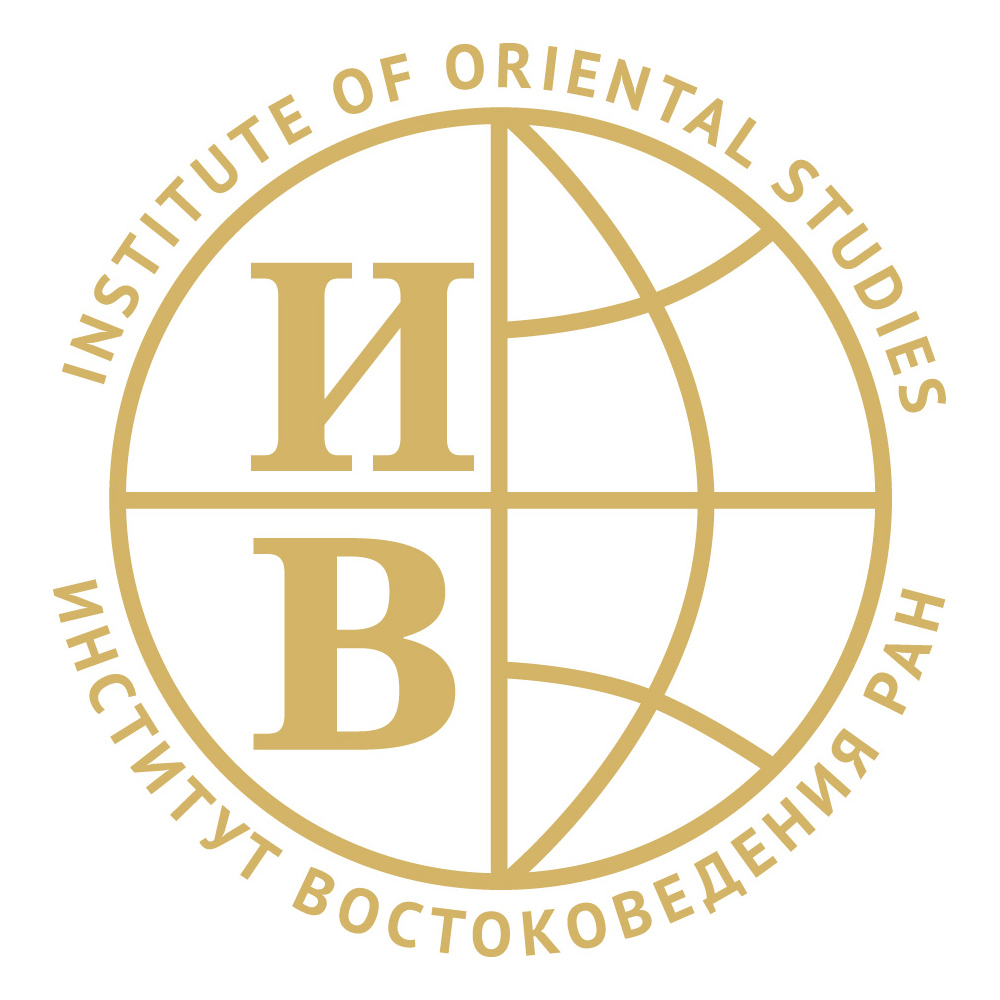Russia ready to fill Middle East void
 US President Donald Trump, who next month celebrates his first year in office, has formally recognized Jerusalem as the capital of Israel. He has ended decades of American diplomacy by ordering the State Department to prepare for moving the US Embassy to Jerusalem, drawing anger and despair from people and leaders throughout the world, who now expect a possible third uprising in the Occupied Territories, the collapse of Palestinian-Israeli peace efforts, the strengthening of extremists and an effect on the standing of the US in the world, mainly in the Middle East.
US President Donald Trump, who next month celebrates his first year in office, has formally recognized Jerusalem as the capital of Israel. He has ended decades of American diplomacy by ordering the State Department to prepare for moving the US Embassy to Jerusalem, drawing anger and despair from people and leaders throughout the world, who now expect a possible third uprising in the Occupied Territories, the collapse of Palestinian-Israeli peace efforts, the strengthening of extremists and an effect on the standing of the US in the world, mainly in the Middle East.
Trump’s recognition of Jerusalem as Israel’s capital was one of his presidential campaign promises, but hardly anyone imagined it would be among those he kept.
Last week’s announcement turned Washington into a dishonest broker in any future talks between the Palestinians and the Israelis, opening the door wide for Arabs to seek Russian, Chinese and European support.
Though Trump received many warnings from Arab and European leaders and UN Secretary General Antonio Guterres, he insisted on his decision to move the embassy.
The Oslo Accords between the Palestinians and the Israelis, which were signed in 1993 in the White House by former Palestinian leader Yasser Arafat and Israeli Prime Minister Yitzhak Rabin, with the attendance of then-President Bill Clinton, stated that the final status of Jerusalem had to be settled by negotiations.
The dominant majority of the international community has condemned this decision and called on the White House to revise it.
Russia’s Foreign Minister Sergei Lavrov characterised it as “defying common sense”, while President Vladimir Putin shared his deep concerns. Putin phoned his Turkish counterpart following Trump’s announcement, calling for the Palestinians and Israelis to “hold back” and to renew talks.
Putin had a short trip to the Middle East on Monday, paying an unexpected visit to Syria, notably the Khmeimim air base, where he met Bashar Assad and ordered Russian troops’ partial withdrawal from Syria. After that, he held talks with President Abdel Fattah El-Sisi in Egypt and Recep Tayyip Erdogan in Turkey. The issue of Jerusalem and the future of the peace talks were among the important topics that were discussed.
Putin’s surprise visit boosts country’s standing in the region amid fallout from US decision to recognize Jerusalem as Israel’s capital.
– Maria Dubovikova
The current situation gives great opportunities to Russia to strengthen its position in the Arab world. Russia has proved to be an honest peace broker in Israeli-Palestinian talks for years — its position is unbiased and unchangeable. The US manoeuver permits Russia to fill the void, attracting the region’s countries into its network of cooperation.
Putin is seizing these opportunities with his brief Middle Eastern tour. Turkey, which is also gaining power in the region, is becoming a key partner for Russia. After the collapse of their bilateral relations following the downing of a Russian jet on the Syria-Turkey border two years ago, their relationship has been fully restored, and has even reached new levels. At the same time, Turkey is one of the few countries which permits itself to use tough rhetoric against the West, and it expressed in a threatening way its disagreement with the White House’s decision on Jerusalem. Russia stands by the side of President Erdogan and other leaders in the region, thus getting into an advantageous position.
The US is deeply involved in all Arab countries politically, militarily, economically and financially, but it arguably has a track record in sowing instability with notorious regime-change policies. Taking this into account, the Arabs are now grappling with the mistakes they made in previous decades.
The issue of moving the embassy dates back to 1995, when the US Congress passed a bill recognizing Jerusalem as the capital of Israel. But that bill includes an item that allows US presidents to effectively postpone the transfer decision for six months to protect American national security interests. US presidents have been postponing this decision ever since.
Moving the US Embassy to Jerusalem is merely symbolic, but it is an adequate reason for possible further chaos in the Middle East.
Palestinians feel they have been negotiating for peace for more than 20 years and have ended up with zero result. The Israeli-Palestinian peace process ended irreversibly with the US recognition of Jerusalem as the capital of Israel — it is a bizarre decision, but how can the Arab world reverse it?
Trump's Double Toe Loop
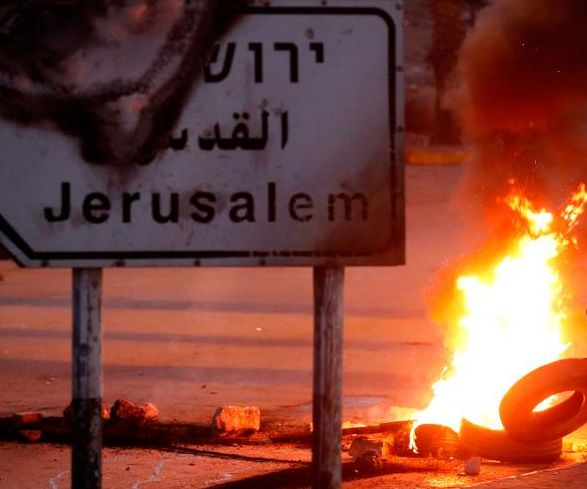
The recent decision of President Donald Trump with regard to Jerusalem is just one more surprise in the endless series of surprises in the Middle East. Numerous analysts overlook the fact that there are actually two separate parts to the decision, which has proved fateful for the Middle East. It is a double toe loop. The first part is about recognizing the whole of Jerusalem as the capital of Israel, while the second is about moving the U.S. embassy from Tel Aviv to Jerusalem. These two points are interrelated. More than this, one seems to logically stem from the other. But, as they say, opinions may differ.
While the situation in the White House has been evolving precisely in this direction ever since Trump's election, I must admit that, until the last moment, I did not want to believe that the president would take such a reckless step. There is no doubt that the move was made under the strong influence of a small group of incompetent people who determine Trump’s Middle Eastern Policy (leading U.S. experts specializing in the region that I have had a chance to talk with see them as incompetent). Their names are well known, as is the motivation behind their recommendations to the President of the United States, who quite enjoys surprising everybody. At least three of them are believed to be supporters of radical right-wing forces in Israel. Shibley Telhami, a Washington-based analyst at the Brookings Institution, wrote: “His advisors live in their own bubble, reinforced by unprecedented inexperience.” At the same time, polls indicate that 81 per cent of Americans, including 71 per cent of Republicans, would prefer Trump to rely on experts in Middle Eastern diplomacy, not inexperienced members of his family and personal lawyers.
It is true that Trump is not abandoning his policy of seeking a truce between Israel and Palestine. However, if we are to believe a leaked plan allegedly devised by Trump’s son-in-law Jared Kushner and submitted by the latter to Saudi Crown Prince Mohammad Bin Salmad Al Saud, handing East Jerusalem over to the Palestinians as the capital of their future state (which appears to be nothing more than a handful of scattered territories). It is hard to imagine any Palestinian leader agreeing to such a plan. There are far more painless and certainly less disgraceful ways to commit suicide. On the other hand, as Steven Simon, former United States National Security Council senior director for the Middle East and North Africa, states in an article for The New York Times International Edition, “For all the talk from successive administrations, a Palestinian-Israeli peace has never been a strategic imperative for Washington”.
Let us list just a few of the possible consequences of Trump’s decisions.
Trump’s decision to bury the already modest results secured by Barack Obama to improve Washington’s relations with the Islamic and Arabic worlds, shape an image of the United States that is not guided by Israel in its foreign policy and set a course that can be defined as neutral with regard to the conflict in the Middle East.
It delivers a deadly blow to the war on terror, and raises the threat of terrorist, extremist and radical religious and nationalist organizations to mobilize new supporters, with terrorists and extremists taking advantage of the desperation of the Palestinians and the fury of Muslims.
It also undermines the reputation of the United Nations, the significance of the UN Security Council’s resolutions (which were passed with the participation of the United States) and, in the broader sense, international law.
It also affects the Middle East Quartet, which was on its last legs as it was, and is now a good as dead. Any attempts to resuscitate the format would be futile. Equally irrecoverable is one of the few channels of constructive foreign political interaction between Russia and the United States. This work needs to be continued, but merely for the sake of the process. There certainly will be no results.
It also undermines the positions of the moderate Palestinian leaders, who are already having a difficult time defending their views before their more radically inclined fellow countrymen.
It also damages the reputation of the allies of the United States around the world and in the Middle East, weakening the United States’ partnership with a number of influential Islamic states – states which had until now been the country’s closest partners. We are talking primarily here about Turkey, a NATO member. The partnership will probably remain, but there will be no more trust. On December 8, Le Figaro published the following headline about Trump’s demarche: “The U.S. President isolates his country in the international arena by recognizing Jerusalem as Israel’s capital.” President of France Emmanuel Macron stated in no uncertain terms that Trump’s decision contravened the relevant UN Security Council resolutions, which does not seem to bother the President of the United States. On the contrary, he appears to derive some kind of pleasure from it. It will be difficult for the Gulf monarchies, which are closely linked to the United States and are now starting to court Israel. Jordan, which is living through difficult times of its own, appears to be in a particularly difficult situation.
Trump’s decision strengthens the positions of Iran, the exact opposite to what the President of the United States wants. We are reminded of 2003, when the United States’ invasion of Iraq made Iran the most influential external force in that country.
The decision is ruining the very concept of the Middle Eastern peace process, which contains such issues as refugees, borders and Jerusalem (the most important and difficult issue), all of which lying at the core of the talks on the so-called final status.
The wave of violence caused by Trump’s decision will be difficult to stop, as the U.S. President does not back down from his word. Anti-U.S. sentiments will continue to mount in the Islamic world, which will put the lives of American citizens at risk. The threat does not just come from the Middle East, but also from Indonesia, Pakistan, Bangladesh, etc.
Trump is doing a disservice to Israel, which needs peace with Palestine in order to secure a safe and comfortable life for its citizens.
Talking about the possible variants, some of my colleagues, the most authoritative American experts on the region, are attempting to move Trump to rectify the damage that his decision has most definitely done to the interests of the United States. In particular, Daniel Kurtzer, former U.S. ambassador to Egypt and Israel and now a professor at Princeton University, suggested in an article for the New York Daily News that Trump did not have to repeal the decision to recognize Jerusalem as the capital of Israel. All he had to do was announce that, in the future, when the plan to create two states in Palestine is implemented, he would also recognize Jerusalem as the capital of Palestine. Trump might also announce that, following the implementation of this plan, he would open a U.S. embassy to that new state in Jerusalem. It is, however, unlikely that the overconfident President will heed the voices of those naively aiming to “correct” his policy.
Why does Trump Need This? And Why is he Doing it Now?
Some believe that Trump wants to suck up to Israel’s right wing (even though much seems have already been done in that direction), and to Netanyahu in particular, who might capitalize on this and avoid prosecution. On the other hand, Trump, as people have come to believe, is primarily guided by domestic policy considerations. Polls carried out by the University of Maryland in November 2017 indicate that 59 per cent of Americans would prefer for the president to abstain from taking sides in the Israel–Palestine conflict. In addition, 57 per cent, including a majority of Republicans, believe he is leaning towards Israel. Another survey, conducted by the Brookings Institution, indicates that 63 per cent of those polled, including 44 per cent of Republicans, are against moving the U.S. embassy to Jerusalem. Even among the respondents who represent Trump’s main beacon of support in U.S. society, Evangelist Christians, only 53 per cent support the moving of the embassy, with as much as 40 per cent being against the move.
Or does he want to appease the Evangelicals? But we have already seen that not everything is clear-cut with the Evangelicals. Nevertheless, Netanyahu is targeting this segment of U.S. society. According to Steven Simon, Netanyahu believes that the next generation of Americans, or the one after that, will no longer contain liberal Jews, and that Evangelical Christians alongside Orthodox Jews will stand up to counteract America’s pressure on Israel.
Or is Trump’s idea to simply shock the international community once again, forcing it to live with any decision that may take his fancy, even the most extravagant ones?
If Netanyahu hopes that the common interest of Israel and Saudi Arabia to restrain Iran will force King Salman of Saudi Arabia and Crown Prince Mohammad to reconcile with the fact that all hopes have been lost for retaining Muslim control over at least some part of the third most significant city in the country (after Mecca and Medina), he is obviously wrong. Israel, and the United States in particular, have always underestimated the central place the Jerusalem issue takes in the eyes of Muslims. It is true that the Saudi Arabian rulers currently view Iran as a greater problem for themselves and the region than the Israel–Palestine conflict. However, the Saudi leader cannot possibly lose Jerusalem. James Dorsey, a well-known Singapore-based expert on the Middle East, believes that Mr. Trump’s recognition and any plan to grant Israel full control of Jerusalem would see the genie turning on the kingdom and its ruling family
It appears that the events in the region are giving Russia a window of opportunity just in time to revitalize the country’s weighted and respectful attitude towards all of its Middle Eastern partners and highlight its role as a unique mediator in conflicts.
They say that an experienced figure skater can do a double toe loop easily. Could the same be said of the President of the United States?
Article published in RIAC: http://russiancouncil.ru/analytics-and-comments/analytics/dvoynoy-tulup-trampa/
Фото: REUTERS/Goran Tomasevic
Trump's declaration and the Palestinian response
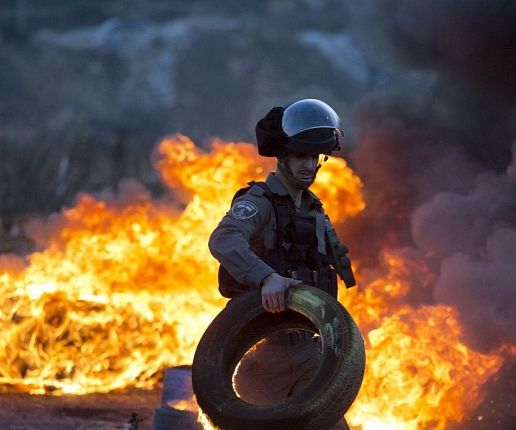 December 9, 2017 was the 30th year anniversary of the first Intifada. So far, the Palestinian responses of yesterday took three tracks: Diplomatic, nonviolent, and violent. Here is a description of each, and I will close with some conclusions.
December 9, 2017 was the 30th year anniversary of the first Intifada. So far, the Palestinian responses of yesterday took three tracks: Diplomatic, nonviolent, and violent. Here is a description of each, and I will close with some conclusions.
The diplomatic track included two crucial steps that were taken immediately: One is cutting the relations with the US administration, and the declaration by Azzam Al Ahmad, member of the central committee of Fateh, that President Abbas will not meet Mike Pence on December 19 in Bethlehem as was scheduled. The second was about submitting a complaint to the UN Security Council by the PLO Mission to the UN against the USA. It is said that point 3 of the article number 27 of the UN Security Council does not allow the USA to use the veto right against a complaint submitted against it. It is also said that nevertheless if the veto will be used, then the next step will be about going to the UN General Assembly to make a resolution under the “United for Peace” clause, which will be an obligatory resolution.
The nonviolent track expressed itself through the hundreds of demonstrations that took place yesterday in East Jerusalem, West Bank and Gaza Strip.
At the same time rockets were launched to Israel from Gaza, this time by Al Qaida and ISIS-affiliated groups. Hamas called for an Intifada without defining clearly its tools, while the Islamic Jihad and the PFLP called for struggle against the Israeli occupation by all means.
These three tracks have the following significance:
The new diplomatic track of cutting contacts with the Americans, if it continues, will mean the end of counting on negotiations as the path to the Palestinian statehood, and going instead to the path of popular resistance (as it was called by Jibril Rajoub in his recent interview with Al Arabiyya), and motivating the Arab world and the international community to take steps against the Israeli occupation and to pressure the United States by using all the diplomatic and the legal means in that direction.
The nonviolent track will be, like it or not, confused with the violent ones. The reasons for this confusion is manifold. In this regard, they are not only about the inability of the Palestinian young people to be fully rational when they are in a mood of rage and anger, but there is something deeper that has to do with the full collapse of trust in the political process of negotiations and its bitter harvest over the last 26 years since the Madrid Conference. Accordingly, it is time for the political leadership to plan and lead a full and continuous nonviolent campaign.
In order for the leadership to be able to convince its people to do so, it will need international support by giving it some concrete results to present to its people, such as more recognitions for the Palestinian State, building Palestinian facts on the ground in area C and East Jerusalem, rebuilding Gaza, creating free access between Gaza and West Bank, and finally taking care of the dignity of the Palestinian refugees until their right of return issue is solved. The non-achievement of these steps will create the conditions that are conducive to growth of violent extremist groups in both West Bank and Gaza, and the Palestinian refugee camps in the Arab neighbouring countries as well.
Article published in Valdai club: http://valdaiclub.com/a/highlights/trump-declaration-and-the-palestinian-response/
How Trump’s decision on Jerusalem can give momentum to Palestinian statehood
 President Trump’s recent decision to recognize Jerusalem as the capital of Israel, and to move the American Embassy from Tel Aviv to Jerusalem represents a crucial change in the American policy. This change can be described as a shift from the previous biased mediator position to the new position of the partner of Israel in its plans towards the Palestinians.
President Trump’s recent decision to recognize Jerusalem as the capital of Israel, and to move the American Embassy from Tel Aviv to Jerusalem represents a crucial change in the American policy. This change can be described as a shift from the previous biased mediator position to the new position of the partner of Israel in its plans towards the Palestinians.
This shift is not only a violation of the international law and the UN resolutions regarding Jerusalem, but also a violation of the 1993 Declaration of principles, signed in the White House and known as the Oslo Accords. According to that Agreement (Article 5), Jerusalem as a whole, including its East and West parts, will be subject to negotiations between the two sides. The agreement also warned against any procedures to be taken unilatarely in a way that would prejudice against the permanent status issues including Jerusalem. President Trump unilaterally decided to go beyond this Oslo commitment and to recognize Jerusalem as the capital of Israel before an agreement about its borders and its division between the two sides. This is a crucial violation.
Process-wise, this move to unilateralism goes against the multilateral/international concerted efforts to solve the Israeli-Palestinian conflict. As such, it will give the Israeli government additional motives to increase its unilateral steps to change the landscape of Jerusalem in a way that will leave no place and no space for the East Jerusalem Palestinians in the city. They will face more and more ethnic cleansing and forced migration. Different means will be used in this regard such as evacuation of the Bedouin neighborhoods around Jerusalem, ousting Palestinian communities from the city (such as Kufur Aqab, and Shufat Refugee camps), and identity cards confiscation.
The response to this American move might take one of two shapes: the first is to give President Trump a chance to develop the “ultimate deal” and present it to the parties in the coming months. Those who adopt such a position say that President Trump referred in his speech to the two-states solution, the preparation for the deal, and that the borders of Israeli sovereignty over Jerusalem will be decided by negotiations. That is in addition to his call for preservation of the status of the Holy places in Jerusalem.
The second argues that the hopes on the Americans to present a solution is over after 26 years of trial and error in the negotiations since Madrid 1991 conference till today. As such, this response calls for adoption of another path: to get to the Palestinian State in the 1967 borders and with East Jerusalem as its capital. It includes creating a Palestinian nonviolent campaign for independence, establishing Palestinian facts on the ground, especially in area C, Gaza and East Jerusalem, linking Gaza and West Bank together, promoting the Palestinian people’s unity, stuggling for more international recognition of the State of Palestine, and suing occupation in international courts.
The second looks to be a path for the creation of a new momentum towards Palestinian statehood. It advocates that the Palestinians should start this path, and then to ask the international community to support it as a path to their national emancipation.
As such, the second position argues the hit can be transformed into an opportunity for the Palestinians to get their right of self-determination in their independent state.
Article published in Valdai Club: http://valdaiclub.com/a/highlights/trump-s-decision-on-jerusalem/
Photo credit: Mohammed Zaatari/AP
Shehab Al Makahleh: Trump's decision will have a very negative effect on the peace process

In today’s speech president Trump announced his decision to move the American embassy from Tel Aviv to Jerusalem without giving details about to which part of Jerusalem, but it is expected to be moved to East Jerusalem. His declaration that Jerusalem is the capital of Israel will have a very negative effect on the peace process, and may even freeze it for the time being, opening the gates for extremists and radicals who will start working underground and even openly. They will be having hubs and will be harbored by many people. In the past they were working secretly and now they will be overtly operating against American and Israeli interests throughout the world. This deal between the Americans and Israel could not happen without an Arab approval of what is called the “Big Deal”, which means that the Palestinians would be having their own capital in Abu Dis, which is located near Jerusalem city. This could not have happened without this kind of deal, without some Arabs. The Palestinians will not be having their own independent state, which they were dreaming of in 1995 when they signed Oslo agreement. Back then the White House already believed that Jerusalem is the capital of Israel, even though the other presidents of the US did not have the courage to announce it since then. But Donald Trump announced it without even thinking of any consequences and repercussions that would happen. That is why before he announced it, he asked the military, American Marines, to be ready for any outcome that would take place in the Middle East or anywhere in the world.
Photo credit: Renewer/Fotolia
Alexander Aksenenok: there's absolutely no logic in Trump's decision on Jerusalem
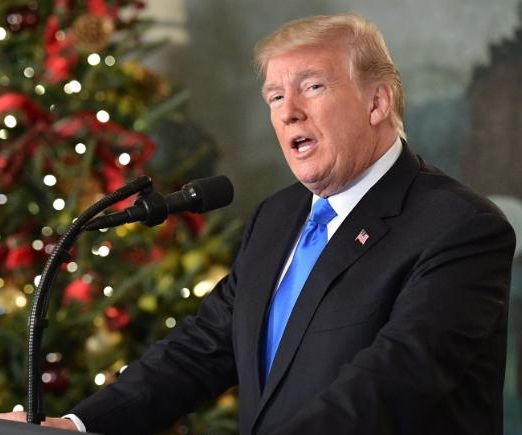 Trump occupies his post for already a year and during this time his Middle-Eastern politics has become an object of heated criticism from active and retired diplomats, Middle-Eastern experts and political scientists. There is even an opinion that Trump, unfortunately, listens more to his relatives, so it is unclear where the White House ends and where Trump’s family begins. He listens more to the opinions of unqualified people on the Middle East, than to the experienced diplomats. Moreover, the situation in the Department of State remains rather volatile. Despite one year has already passed, many offices remain unoccupied and Tillerson prefers a rather authoritarian mode of management, without listening to the Middle-Eastern specialists. At the same time there are several points of disagreement between Tillerson and Trump on the Middle East, which have become public.
Trump occupies his post for already a year and during this time his Middle-Eastern politics has become an object of heated criticism from active and retired diplomats, Middle-Eastern experts and political scientists. There is even an opinion that Trump, unfortunately, listens more to his relatives, so it is unclear where the White House ends and where Trump’s family begins. He listens more to the opinions of unqualified people on the Middle East, than to the experienced diplomats. Moreover, the situation in the Department of State remains rather volatile. Despite one year has already passed, many offices remain unoccupied and Tillerson prefers a rather authoritarian mode of management, without listening to the Middle-Eastern specialists. At the same time there are several points of disagreement between Tillerson and Trump on the Middle East, which have become public.
Speaking about this very decision, now I can say that there is absolutely no logic in it. Even from the point of view of the US national interests in the region. There is an opinion that many of Trump’s advisers have planted in his mind an idea that now the situation in the Arab world has changed so much that the Arab states do not pay attention to the Palestinian issue and that his decision to move the embassy to Jerusalem or to recognize this city as Israel’s capital will not provoke backlash in the Arab world. He thinks that maybe Arabs will have some minor protests, but not like in the 50ies and 60ies. Probably, such thoughts made Trump pass such decision. But there is absolutely not logic in it, and the reaction of Arab states, even of Saudi Arabia that now established special relations with Israel, of Iraq, Egypt, of European states like France, is naturally negative and will complicate the resolution of many other regional issues. This will hamper Trumps policy not only in the Palestinian-Israeli dimension, but also in Europe and in the Islamic world as a whole.
Photo credit Mandel Ngan/AFP
Al Aqsa Intifada, features, regional and international impacts, and horizons
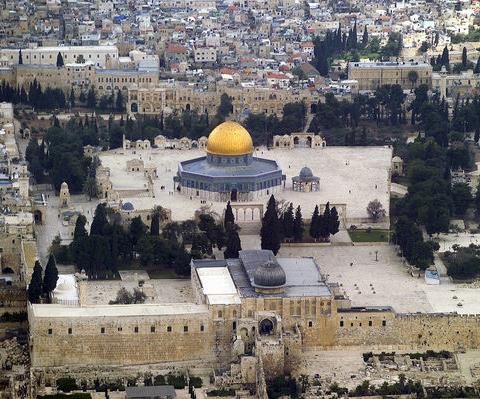 It was an uprising with all its meaning. This is what happened in the events of the 14th to the 28th of last July, where the "Al-Aqsa Intifada" took place.
It was an uprising with all its meaning. This is what happened in the events of the 14th to the 28th of last July, where the "Al-Aqsa Intifada" took place.
All the five features of the first Intifada existed:
First:Participation between all generations and ages, between the sexes, between all classes, social groups, professions and local communities, between Muslims and Christians among our people, between Palestinians of Jerusalem and Palestinians inside the Green Line, between religious and secular. Between the field leadership and the street,
All participated together to protect our national existence, and its meaning embodied in the image and structure of the Al-Aqsa Mosque.
Secondly, and third:National unity, solidarity and cohesion: unite all behind national United slogans: the slogans of factions were not raised, and the compitition between everyone to provide food and drinks and other needs of the protesters without waiting for any support or funding. Every one was following the decisions of the four Shiekhs, the sound was one and the act was the same.
Fourth, the characteristic of continuity and communication as a reflection of national resilience , self-esteem, and a high sense of dignity, was expressed by the absence of refraction in the face of the repression of the occupation and its daily attacks on the protesters. And what amazed the Israeli police that the number of protesters was increasing day after day despite all the use of the methods of repression and abuse. After each "meal" of oppression , the number of protestors increased. After the next "meal" of oppression, it increased more and more. Perhaps this was the main factor that made the occupation forces retreat in the face of the high psychological resilience and the unrelenting willingness to give to our people.
Fifthly, the characteristic of the peaceful and non violent nature of the Intifada, and the measures of the occupation have not changed its course. The preservation of this character has enabled the continued participation of all groups, despite their varying capabilities, and has enabled the world to stand by and support the creative approach adopted by the Intifada participants.
Therefore, we have experienced an Intifada, not measured by the number of days, but measured by its qualities, and what it achieved:
In the context of what has been achieved, many are trying to limit what has been achieved, which is only to prevent the occupation government from imposing electronic gates and surveillance cameras. This flawed view has not been able to take into account the following Palestinian, Arab, Islamic and international results:
Let us start with a Palestinian: a living model has emerged here, and an additional glimmer of examples of what popular resistance can achieve, a model whose lessons and mechanisms will be absorbed and replicated elsewhere. Unfortunately, this model has not yet affected both sides of the divide, leading them to unity.
On the other hand, the Arabs were forced to hold an extraordinary meeting of the ministers of Forwign Affairs on the subject, and Jordan stood on its feet to follow up the event as well as other Arab countries. It is important also to say that those who were thinking of normalizing their relations with Israel would think now and after the Al-Aqsa Intifada a thousand times before they take such steps.
On the popular Arab and Islamic level, we have seen the demonstrations of anger that have taken place in Amman, Istanbul and many other Arab and Islamic capitals and cities.
Europe: At the beginning, European countries called on "the parties to exercise restraint and not to be dragged into violence," according to their statements, but later, as the nature of the matter became a further step to impose full Israeli control of Jerusalem, there was a change in the European position, which called on the preservation of " The Religious and Historical Status of Al-Aqsa Mosque: The Status Quo ".
The problem was in the US position, which completely adopted Netanyahu's speech on the need for electronic doors and cameras to ensure its security, so America chose to work to ensure the security of the occupation, as an alternative to work to end it.
In this context, there is a need to speak with the Americans in order to understand that the Al-Aqsa Intifada must make them think a thousand times before taking the foolish step of moving the US embassy from Tel Aviv to Jerusalem.
The Al-Aqsa Intifada has achieved all these results. What remains important is the continuation of the popular struggle for the accumulation of other achievements, such as the end of the provocative settlers' incursions into the Aqsa Mosque, the cessation of settlement expansion and others as steps on the way to end the longest settler colonial occupation of the last century.
Syrian Conflict Moves Closer an End
 Article by Shehab Al-Makahleh and Maria Dubovikova
Article by Shehab Al-Makahleh and Maria Dubovikova
Quiet meetings in Amman between the Syrian opposition and other parties are a step forward.
The Syrian conflict is moving closer to its end. Despite global expectations, the key settlement process is occurring on the ground and in closed talks, not in front of the media and, therefore, not manipulated by geopolitical players and games in Astana or Geneva. Such formats on the ground and in talks beyond closed doors prove to be more successful and fruitful than all the pomp covered by the media, which just recycles the message of “no outcome.” But through minor steps the greatest goals are achieved.
One of such talks was held recently in Jordan for three days between representatives of Syrian armed forces and officials from Jordan, the United States and Russia. The meetings discussed the logistics of the de-escalation zones in southwestern parts of Syria, and they demanded that Al Nusra fighters pull out from this area. This move would give the Syrian army and its allies, as well as Jordan and its allies, the impetus to control the eight-kilometer “pinnacle” that has been a thorny issue for the Syrian, Israeli and Jordanian armies.
The talks included 58 representatives of the Syrian rebel alliance, including the Free Syrian Army, who label themselves the “Southern Front.” The meeting also discussed moving some of these forces to Al Shaddadi Military Camp near Deir al-Zour in order to liberate it from the Islamic State (Daesh).
After the meeting with the Syrian opposition, Jordan has started to change its tone toward Syria and its regime. This fact can be inferred from the recent statements of Jordanian officials, stressing the kingdom’s great interest in southwestern Syria. Official statements on-record and off-record about the security and stability of this part of Syria show that the region is of strategic interest for Jordan and the whole Middle East — an implicit signal that there is no rejection of the current government or Syrian President Bashar al-Assad. A ceasefire control mechanism brokered by Russia, the US and Jordan in southwestern Syria is nearly ready, as Jordanian Minister of State for Media Affairs Mohammad Momani said following the Amman meeting on behalf of the Syrian opposition.
The Jordanians know very well that such phrases are aimed at approaching the nearest possible distance from the logic of the Syrian regime, which today prides itself with so many victories on the ground — recapturing many strategic locations that are deemed major victories, especially the “dubious melting away” of Daesh and the suspicious absence of other Islamic factions such as Al Nusra, which are supported by regional powers. The recent breakdown of many factions has led the Syrian armed forces to gain the momentum and to spread its troops into many parts of Syria, with the aim of liberating the whole country before the end of the year.
Assad has refused to demarcate the southern border by delineating an area of eight kilometers in southern Syria that would secure Jordan and Israel as well near the Nasseeb border crossing point. In other words, the Syrian president rejected the opening of the crossing point that would serve both Jordan and Syria. However, with Eid Al Adha approaching, the opening of the border indicates a gateway for cooperation, according to sources close to the president.
RUSSIA, TURKEY AND ISRAEL
More importantly, Jordan is investing its relatively “sophisticated communications” with Russia. In a closed-door meeting at the royal palace a few days ago, discussion about President Vladimir Putin described the Russian leader as a “trusted friend” and a “credible man.” Until now, Jordan has tried to reopen the Nasseeb crossing point, but President Assad has been “dodging” the issue for the past few months. With the agreement, Russia provided an opening for the Syrian leader to voice willingness to reopen the crossing point under certain security arrangements that will guarantee the eight kilometers. The whole area that will be the demilitarized zone in southern Jordan will include a 30-kilometer-wide strip in Syria running parallel to the Jordanian border.
Simultaneously, the Jordanian government held talks to reopen the Turaibeel crossing point between Jordan and Iraq. Turaibeel was closed after Daesh emerged in the eastern region of Iraq but now it is open, according to Jordanian officials. This fact is confirmed by Iraqi sources who said there are joint security and military operations nearby the Jordanian and Iraqi borders. Private meetings helped to set the stage for the Turaibeel reopening where cooperation is essential. The Jordanian official spokesperson confirmed the talks publicly a few days ago with regard to the reopening of the Turaibeel crossing point.
Jordan is also focusing on Turkey’s recent public position that a “terrorist group” should not be allowed to have a base in northern Syria, as this factor would threaten other safe or de-escalation zones in the country. The Jordanians now strongly believe that Amman has great interest in Syrian unity, and they pin high hopes on the tripartite deal with the Americans and Russians for a “long-term ceasefire” in southern Syria.
The tripartite deal has neutralized Israel as this agreement serves Israeli security as well; yet Israel is pushed away from the Syrian battleground and any Israeli intervention in Syria remains a constant possibility. However, there are multiple hidden indicators that determine the mechanism of monitoring the ceasefire, which will be announced in its final stages very soon as the Syrian predicament is reaching its finale.
Amman is struggling behind the scenes to put in place a mechanism that would be mandatory for all parties concerned to adhere to for a Syrian truce. The Americans believe the truce will eventually lead to the formation of a “Daraa region” within a Syrian federal system that will determine matters in the future Syria. The so-called long truce is called “a wide, low-tension zone” by the Russians.
At present, the Syrian government sounds very “cooperative” and in line with Russian demands. Recent battlefield successes mean the Syrians are keen not to waste the army’s efforts, and they want to strongly invest manpower into rebuilding Syria and to avoid military attrition in southern regions of the country, instead focusing on a magnet for Daesh: Deir al-Zour.
Overall, Jordan seeks to stabilize Syria now and supports the de-escalation zones scenario not only in order for the region to prepare for the return of Syrian refugees to their homeland, but also to ensure Jordan’s share and role in any future regional and international arrangement in Syria’s south.
Jordanians believe they have the “winning card” as the closest and most connected to the bloc of Daraa tribes and to Druze tribes in Jabal Al Arab of northern Jordan. While it is possible to discern “differences” that must be monitored between all parties in any private and quiet arrangements in southern Syria, Jordan’s focus on a “ceasefire monitoring mechanism” is a realpolitik solution to secure the best possible military — and then political — truce by the borders of the Hashemite Kingdom.
Article published in Fair Observer: https://www.fairobserver.com/region/middle_east_north_africa/syria-bashar-al-assad-jordan-russia-iraq-middle-east-news-01214/
Photo Credit: OBJM / Shutterstock.com
The two-state solution the only way out for Arab-Israeli conflict
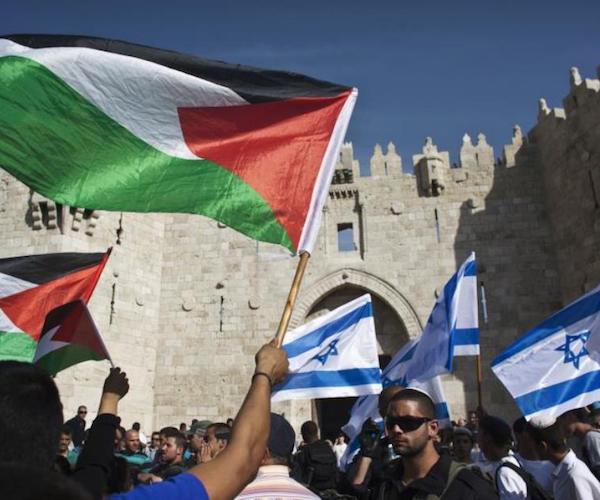 Arab countries led by Jordan and Saudi Arabia have been pushing the Americans and the European Union to prepare for a framework agreement between the Palestine National Authority (PNA) and Israel based on a two-state solution, which ensures a Palestinian state in the areas occupied by Israel in 1967.
Arab countries led by Jordan and Saudi Arabia have been pushing the Americans and the European Union to prepare for a framework agreement between the Palestine National Authority (PNA) and Israel based on a two-state solution, which ensures a Palestinian state in the areas occupied by Israel in 1967.
Though the laws of gravity are not in favor of Arab countries; yet, the endeavors of both Jordan and Saudi Arabia to solve the Arab Israeli conflict seem a preventive measure to avert any negative and destructive consequences that would arise if the stalemate between Palestinians and Israelis continue further with blurry hazy image.
Following the visits of King Abdullah II of Jordan and Deputy Crown Prince Mohammad bin Salman of Saudi Arabia to Washington, Americans have planned to initiate a peace conference between Arab states and Israel to discuss the issue of stalemating talks between the Palestinians and the Israelis which have led to deadlock to their talks.
Arabs believe that a two-state solution is the cornerstone to end the conflict in the Middle East, and that Americans should play a key role to help both the Palestinians and the Israelis reach an agreement that paves the way to establish a Palestinian state in pursuance with United Nations Security Council Resolutions 242 and 338.
Any proposal to create one state where both nations live happily is refused by Arab countries and their leaderships and for sure by Palestinians as this means the Palestinians abroad will not be able to return to their country. This would be another impediment for future cooperation between Israel and Arab countries at trade and economic levels. All Middle Eastern countries are vulnerable to social unrest and extremism if the main reason for the conflict is not addressed and unresolved as further regional hostility to Israel would intensify and lead to a new type of skirmishes with new war players.
The Arab Summit in Jordan will highlight this issue and the committees concerned will be discussing it thoroughly in order to ink an accord between the PNA and Israel on the two-state paradigm with American and Russian direct mediation and honest brokerage. No super power is allowed to distance itself from this mission as the internal situation in Middle Eastern countries is exacerbating due to economic and social pressures which would lead to implosion in a number of states that would destabilize the whole region and lead to eccentric comprehensive war with new fighting techniques leading to street wars that no army would be able to stand.
The meetings of American President Donald Trump with Israeli Premier Benjamin Netanyahu and Palestinian President Mahmoud Abbas aim to probe into means to launch a new pace conference to discuss further details, taking the concerns of both Netanyahu and Abbas into consideration.
However, the nonchalant comments and statements by American officials regarding the one-state or two-state solution complicated matters as both Palestinian and Israeli leaders cannot totally control their people and the situation if it aggravates. The one –state solution is rejected by a majority of Israelis as per a survey conducted in Israeli last February which showed that 55 per cent of Israelis and 44 per cent of Palestinians support the two-state solution for two people. The years of acrimony and hostility between both nations should come to an end and a new age of Arab-Israeli relationship should start as a new dawn has just started with a new American president who seeks to find Arabs and Israelis in one boat against Iran. Trump is currently working along with his administration on establishing a new paradigm for peacemaking, without abrasively encroaching upon Netanyahu’s views towards Arab Israeli conflict. In other words, any solution should be attuned with Israeli right wing opposition principles.
At present, we are at the threshold of either of a two-state solution or radicalism and wild-eyededness. Thus, the two-state paradigm should not be a fairy tale at Trumpland or a dream in the Palestinian Wonderland. Arab leaders are not more than ever aware that any further escalation in the Palestinian lands would lead to a third Intifada or uprising which will spill over oil on fire to turn the region into an erupt volcano as all Middle Eastern states with no exception are on “hot tin roof”.
The Arab Summit should reiterate that there is no solution to the regional conflicts without a Palestinian polity with its people to have the sole right of self-determination. This can be brokered by the two super powers: Russia and the USA. The sooner to resolve the conflict, the better it will be to foil all radical attempts to recruit more jihadis.
In 2002, Arabs offered their Peace Initiative in Beirut Summit based on full Israeli withdrawal to the borderline before 1967 and a Palestinian capital in East Jerusalem. Now, at Amman Summit they can recap this initiative with American support to create the proposed affinity of Sunni Arab countries and Israel to counter the increasing Iranian threats to Arab states. This alliance would also help stand against extremism and terrorist risks.
As far as the two-state solution might be unseen at least in the near future due to internal troubles in Israel, the PNA and the USA, the status quo will be last until further notice until an honest mediator or broker takes the initiative to end this dispute which lasted for over 69 years. An honest mediator will be in charge of understanding the nature of the Arab-Israeli conflict in terms of sovereignty and religion including the holy shrines in East Jerusalem. If there is no cooperation from the UN and from other neighboring states, the issue will amalgamate. If the issue of the holy shrines is left unrequited, radicalism and jihadi threats will be in the offing.
Jerusalem: Reconsidering the settler colonial analysis
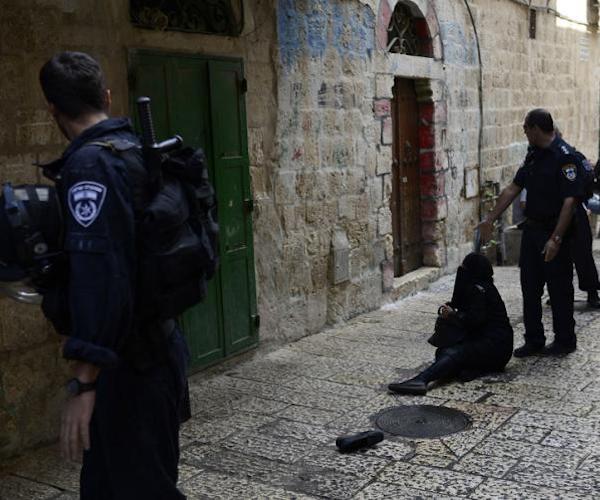 Introduction: The re-emergence of the settler colonial approach in the academic world
Introduction: The re-emergence of the settler colonial approach in the academic world
The 1940's to the 1970's was a period of decolonization and self-determination for many countries in Asia and Africa. An immense amount of academic and intellectual writings about colonialism, neo-colonialism as well as settler colonialism accompanied that process of decolonization. At the same time, the UN released several resolutions and documents condemning colonialism and seeking the immediate fulfillment of the right to self-determination for all peoples living under colonial rule. The most famous among these resolutions is the 1960 UN General Assembly resolution about decolonization.
The writings on colonialism at that time focused on military colonialism and the right of all peoples to self-determination and emancipation from colonial occupation, while neocolonialism focused on how colonialism "left through the door and came back through the window", using economic and cultural means rather than direct military control as it was the case with colonialism before.
The writings about settler colonialism focused on a type of colonialism which combines military occupation with a settler colonial component that included taking over land, space, territory and landscape, through displacement and uprooting of indigenous populations, and replacing them by another population. This created, at the expense of the dispossession of the indigenous people, a new society and state with a different type of space, landscape, language, and culture. The Palestinian academic and intellectual Fayez Sayigh was one of the pioneers of analyzing the Israeli Zionist settler colonial project, alongside Edward Said, whose book Orientalism is considered a leading work in the field. He focused on the approach of Western scholars towards the Orient who wrote about western connections to the land and the territory of the Orient while disregarding the peoples living in that territory as if they are non-existent. The contribution of the seminal writings of the Egyptian Scholars Abdel Wahab Al Masiri and Majdi Hammad should be also mentioned in this regard. Algerian, South African, and Irish writings were published during that period analyzing the settler colonial projects in these respective countries and their different fates.
Contrary to the colonial military occupation that has a clear point of beginning and end, settler colonialism is a continuous process without an end, and as the pioneer in the recent studies of settler colonialism, Patrick Wolf, put it “It is a structure rather than an event”( Wolf, 2006).
After the 1970's it was only in the beginning of the third century that the settler colonial approach came back to the academic discourse for example in presentations during the International Studies Association (ISA) conferences since 2013, and the publication of the Settler Colonial Studies online Journal by Taylor and Francisin the same year.
The significance of settler colonialism regarding Jerusalem
The quotation by Patrick Wolf above, demonstrates that the Zionists settler colonial project which started in the 19th century continues to be used against the Palestinians in the West Bank (especially in Area C that constitutes two thirds of West Bank) and East Jerusalem till today. It uses the same methods of dispossession, ethnic cleansing, and spacio-cide (as it was called by Sari Hanafi) that were used in the prior 1948 period. Therefore, the Palestinian State is limited to Gaza Strip, while the West Bank and East Jerusalem are subject to a continued Nakba with the 1948 and 1967 transfers as moments of escalation. These phenomena are continuing today, using different methods of internal and external displacement, including also the Palestinians inside Israel. They faced different internal displacements 1948 to 1967, which have continued ever since, including for example the destruction of Palestinian Bedouin villages in the Negev today.
The settler colonial approach can help to identify the common discrimination in Israeli policies against all the Palestinians regardless of whether they live inside Israel, in the 1967 occupied territories, or as refugees abroad. In addition to the commonalities, this approach can assist in finding significant characteristics for each situation or each group. This article will use the approach to further examine the situation in Jerusalem..
The settler colonial approach can help overcome gaps and discrepancies that limit the four other approaches of analysis of the situation of Jerusalem and West Bank. These four approaches are: Firstly, the inequality approach that analyzes the aspects of inequality in Jerusalem, while seeking to suggest how to overcome them, with very little focus on ending the settler colonial project in the city. This approach is adopted and applied by Israeli organizations who prepare analyses or conduct projects for more equitable relations in the city within the current framework of the existing power structure.
The Occupation Approach
The second approach considers the situation in East Jerusalem to be just an occupation, as the Palestinian Authority and the international community keep stressing, and asking for its end. Such a call according to the International law which does not accept any form of occupation, including in regard to Jerusalem, is not wrong, but misses the point that Israel is an ideologically driven state. It is even better described as state-project that considers itself to continue to be a ‘state in the making’, with its final size and borders still to be determined.
The Combination of Colonialism and Neo-colonialism Approach
The third approach regards what is taking place in East Jerusalem by Israel as a combination of colonialism and neo-colonialism (by placing Jerusalem under full Israeli economic domination in addition to the military occupation). Such an approach is partially right, but still has to be completed with the settler colonial approach. In the short run including settler colonialism will assist to analyze and follow the state driven and the state supported settler colonial project, and in the long run it will help to see how the colonial and the neocolonial approaches are practiced within the framework of a settler colonial project. Discrimination as practiced temporarily till the achievement of the full formation of the settler colonial project at the expense of the indigenous population, leads to a point of time when the colonial and the neocolonial policies will cease to exist due to the transfer of all indigenous population.
The Ethnocracy Approach
The fourth approach describes the situation in East Jerusalem to be the result of Israel being an ethnocracy rather than being a democracy. This view is based on the inclusion and exclusion of people from the Demos according to a certain ideology, which results in this case in including the Jews all around the world eligible to the citizenship in Israel, including also the Israeli Settlers who live in the Occupied Palestinian Territories and not in Israel, while depriving the Palestinians who live inside Israel of equal civil rights and excluding the Palestinians in the 1967 occupied territories from citizenship. In this sense, the ethnocratic state claims and seeks to represent its ethnic group and to promote its domination regardless if they live inside or outside its borders, while at the same time it limits or completely denies the civil rights of other ethnicities. Such an analysis led Yiftachel to suggest that Israel stopped its settler colonial project after the Oslo Accords 1993, and moved to the politics of what he called "creeping apartheid" against the Palestinians (Yiftachel, 2012).
The problem of such analysis is twofold: On the one hand it focuses mainly on the inclusion and the exclusion from the Demos, and less on the territorial issue that is very relevant to the Palestinians. On the other hand: It's conclusion that the “creeping Apartheid” became an alternative to settler colonialism cannot explain the continuous settlement expansion, which especially increased during the Post Oslo period as empirical data and research has shown.
Like the third approach, the fourth one also focuses on the means of discrimination against the equal rights of Palestinians in Jerusalem at all levels, ignoring their Palestinian identity by considering them to be as "Jordanian citizens residing permanently in Israel" till they will be transferred. This is already partially enforced by the different incidents of ethnic cleansing that took place against the Palestinian Jerusalemites since 1967. Some took the shape of external displacement and some others internal displacement, such as: the evacuation of part of East Jerusalem Palestinians and expelling them to Jordan during 1967 war; the expulsion of Al Sharaf neighborhood population of the Old City of Jerusalem to Shuafat refugee camp directly after the 1967 occupation; the deportations that followed to Jordan, and the ethnic cleansing through identity cards confiscations on the basis of the law of entry to Israel of 1952 that was practiced in East Jerusalem when it was occupied in 1967.
Main features of the Israeli settler colonial project in Jerusalem
In Jerusalem, the settler colonial project is practiced while using a set of complex intertwined procedures that include: dispossession (such as uprooting from land by land confiscation, from the house by house demolition among other different types of displacement); ethnic cleansing (by deportations and identity card confiscations and uprooting and re- concentration in other places like what is happening with the Bedouin collectives around Jerusalem). A third element is the isolation of those who continue to live in East Jerusalem by separating East Jerusalem from the West Bank and Gaza by the closure that started in the end of March 1993, and the separation of East Jerusalem communities from each other by creating Israeli Jewish settlements in between them, by discrimination when it comes to public services transforming Palestinian communities in East Jerusalem into slums of poverty and underdevelopment, and lastly the isolation is enforced by what I called "the inclusion in Israel, but without integration in it" (Salem 2006).
These politics of disposition, ethnic cleansing of part of the Palestinians in East Jerusalem, and the isolation of those who continue to live in the city, are combined with other policies such as: The de-development of East Jerusalem by separating it from Palestine and the world economies on the one hand, and ignoring the developmental needs of these communities on the other hand. The de-equalization regarding the rights of those Palestinians who still live in the city is a concept that goes beyond the term" inequality". The treatment of people in East Jerusalem is an inequality that is created by a state premeditated policy, therefore it is more a de-equalizing process. The de-development and the de-equalization are combined with a de-democratization process by dissolving the Jerusalem Palestinian municipality of 1967, and preventing the Palestinians from holding elections ever since, and by preventing the East Jerusalem Palestinians from defining themselves as Palestinians through insisting that they are " Jordanian citizens residing permanently in Israel" since Israel’s annexation of East Jerusalem on 28/6/1967. Finally, all of this is combined with the preservation of the refugee status of those Palestinian Jerusalemites who were displaced in 1948 and 1967 as part of the Palestinian refugees. When Israel allowed some of the refugees to come back to the West Bank and Gaza as part of Oslo implementation, Palestinians who are originally from Jerusalem were not allowed to come back to their city but only to the West Bank and Gaza.
These politics were followed by two other politics of replacement: One of them is the Jewdiazation of the place, space, territory, and the landscape, and the other is the Israelization process which on the one hand creates an Israeli majority in East Jerusalem, and on the other hand imposes the Israeli law on the Palestinian people and institutions in East Jerusalem.
Where to? Comparisons and Alternatives
If the settler colonial project is based on the concept and the practice of full exclusion, then it's fate depends on different internal and external factors. When there were no external impeding factors, the situation led to genocides against the indigenous population as happened in the cases of the U.S. and Australia. The opposite outcome is the merger of the settler colonial community with the indigenous population majority as happened in South Africa after 1994 due to the international boycott and sanctions against the South African apartheid system combined with the nonviolent struggle of the African National Congress led by Nelson Mandela. In a third case, the settler colonial project can end in evacuation of the settlers as in Algeria in 1962 due to the split between the settlers and the French Government, and due also to the armed struggle by the Algerian National Liberation Front.
In the case of Jerusalem and Palestine, option three seems not likely. On the one hand the settler community is a decision maker in the Israeli Government, and the Palestinians have not proven the capability to liberate Palestine by the means of armed struggle.
The history of the Israeli Palestinian conflict has shown a signs of population transfer combined with partial genocides on the way, therefore the future options seem to be the following: The first is an Israeli repetition of the forced transfer of Palestinians including and maybe starting with those who live in East Jerusalem for a third time. This is likely if the current trend in Israeli politics, that started talking openly about the transfer, will continue. If at the same time the ongoing international and Palestinian politics will continue to focus on the revival of negotiations between the two sides instead of focusing on confronting the settler colonial project and creating Palestinian facts in the ground, that will equally increase the likeliness of further displacement.
However, if alternative policies will be promoted, it might be possible to reverse the settler colonial project towards either a two state solution based on the 1967 borders or a one state solution with equal rights for all. The main strategies that might lead there are: A continuous and comprehensive, nonviolent and creative Palestinian campaign that includes actions on the ground and components of developmental and diplomatic resistance. Parallel to that, an international recognition of the State of Palestine - after 50 years of occupation and 100 years of Balfour declaration - with the political will to use all diplomatic, economic and developmental means that will ensure its implementation.
Finally, it should be noted that the Israeli settler colonial policies in East Jerusalem have been expanded to Area C in the West Bank, leading to the existence of a Jewish settler majority in the area versus the minority of Palestinians who live there. The issue of the holy places in Jerusalem was not discussed here, and the formal issue of the different types of identity cards given by Israel to Palestinians in East Jerusalem and the West Bank, but these two issues do not have great impact regarding what is common between Jerusalem and area C in connection to the expansion of the settler colonial project in both of them. Therefore, the issue of Jerusalem is more and more, though not exclusively, becoming an issue of Palestinian rights as a whole.







